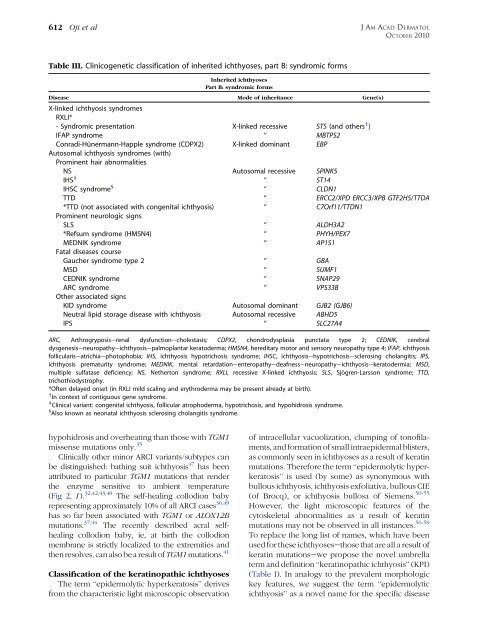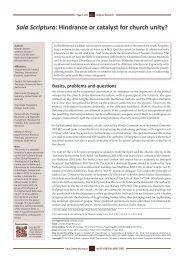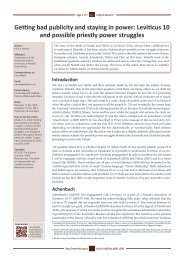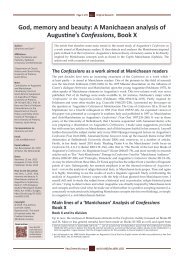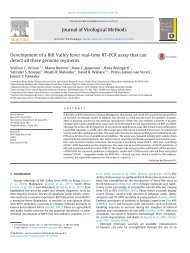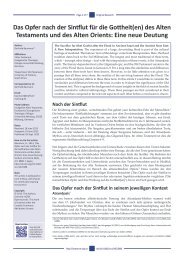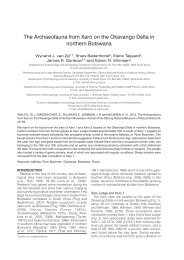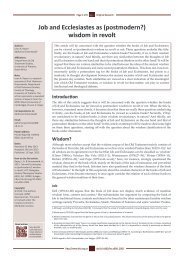Revised nomenclature and classification of inherited ichthyoses ...
Revised nomenclature and classification of inherited ichthyoses ...
Revised nomenclature and classification of inherited ichthyoses ...
You also want an ePaper? Increase the reach of your titles
YUMPU automatically turns print PDFs into web optimized ePapers that Google loves.
612 Oji et al<br />
Table III. Clinicogenetic <strong>classification</strong> <strong>of</strong> <strong>inherited</strong> <strong>ichthyoses</strong>, part B: syndromic forms<br />
hypohidrosis <strong>and</strong> overheating than those with TGM1<br />
missense mutations only. 35<br />
Clinically other minor ARCI variants/subtypes can<br />
be distinguished: bathing suit ichthyosis 47 has been<br />
attributed to particular TGM1 mutations that render<br />
the enzyme sensitive to ambient temperature<br />
(Fig 2, I ). 32,42,43,48 The self-healing collodion baby<br />
representing approximately 10% <strong>of</strong> all ARCI cases 36,49<br />
has so far been associated with TGM1 or ALOX12B<br />
mutations. 37,44 The recently described acral selfhealing<br />
collodion baby, ie, at birth the collodion<br />
membrane is strictly localized to the extremities <strong>and</strong><br />
then resolves, can also be a result <strong>of</strong> TGM1 mutations. 41<br />
Classification <strong>of</strong> the keratinopathic <strong>ichthyoses</strong><br />
The term ‘‘epidermolytic hyperkeratosis’’ derives<br />
from the characteristic light microscopic observation<br />
Inherited <strong>ichthyoses</strong><br />
Part B: syndromic forms<br />
JAM ACAD DERMATOL<br />
OCTOBER 2010<br />
Disease<br />
X-linked ichthyosis syndromes<br />
RXLI*<br />
Mode <strong>of</strong> inheritance Gene(s)<br />
- Syndromic presentation X-linked recessive STS (<strong>and</strong> others y )<br />
IFAP syndrome ‘‘ MBTPS2<br />
Conradi-Hünermann-Happle syndrome (CDPX2)<br />
Autosomal ichthyosis syndromes (with)<br />
Prominent hair abnormalities<br />
X-linked dominant EBP<br />
NS Autosomal recessive SPINK5<br />
IHS z<br />
‘‘ ST14<br />
IHSC syndrome §<br />
‘‘ CLDN1<br />
TTD ‘‘ ERCC2/XPD ERCC3/XPB GTF2H5/TTDA<br />
*TTD (not associated with congenital ichthyosis)<br />
Prominent neurologic signs<br />
‘‘ C7Orf11/TTDN1<br />
SLS ‘‘ ALDH3A2<br />
*Refsum syndrome (HMSN4) ‘‘ PHYH/PEX7<br />
MEDNIK syndrome<br />
Fatal diseases course<br />
‘‘ AP1S1<br />
Gaucher syndrome type 2 ‘‘ GBA<br />
MSD ‘‘ SUMF1<br />
CEDNIK syndrome ‘‘ SNAP29<br />
ARC syndrome<br />
Other associated signs<br />
‘‘ VPS33B<br />
KID syndrome Autosomal dominant GJB2 (GJB6)<br />
Neutral lipid storage disease with ichthyosis Autosomal recessive ABHD5<br />
IPS ‘‘ SLC27A4<br />
ARC, Arthrogryposiserenal dysfunctionecholestasis; CDPX2, chondrodysplasia punctata type 2; CEDNIK, cerebral<br />
dysgenesiseneuropathyeichthyosisepalmoplantar keratoderma; HMSN4, hereditary motor <strong>and</strong> sensory neuropathy type 4; IFAP, ichthyosis<br />
folliculariseatrichiaephotophobia; IHS, ichthyosis hypotrichosis syndrome; IHSC, ichthyosisehypotrichosisesclerosing cholangitis; IPS,<br />
ichthyosis prematurity syndrome; MEDNIK, mental retardationeenteropathyedeafnesseneuropathyeichthyosisekeratodermia; MSD,<br />
multiple sulfatase deficiency; NS, Netherton syndrome; RXLI, recessive X-linked ichthyosis; SLS, Sjögren-Larsson syndrome; TTD,<br />
trichothiodystrophy.<br />
*Often delayed onset (in RXLI mild scaling <strong>and</strong> erythroderma may be present already at birth).<br />
y<br />
In context <strong>of</strong> contiguous gene syndrome.<br />
z<br />
Clinical variant: congenital ichthyosis, follicular atrophoderma, hypotrichosis, <strong>and</strong> hypohidrosis syndrome.<br />
§<br />
Also known as neonatal ichthyosis sclerosing cholangitis syndrome.<br />
<strong>of</strong> intracellular vacuolization, clumping <strong>of</strong> ton<strong>of</strong>ilaments,<br />
<strong>and</strong> formation <strong>of</strong> small intraepidermal blisters,<br />
as commonly seen in <strong>ichthyoses</strong> as a result <strong>of</strong> keratin<br />
mutations. Therefore the term ‘‘epidermolytic hyperkeratosis’’<br />
is used (by some) as synonymous with<br />
bullous ichthyosis, ichthyosis exfoliativa, bullous CIE<br />
(<strong>of</strong> Brocq), or ichthyosis bullosa <strong>of</strong> Siemens. 50-55<br />
However, the light microscopic features <strong>of</strong> the<br />
cytoskeletal abnormalities as a result <strong>of</strong> keratin<br />
mutations may not be observed in all instances. 56-59<br />
To replace the long list <strong>of</strong> names, which have been<br />
used for these <strong>ichthyoses</strong>ethose that are all a result <strong>of</strong><br />
keratin mutationsewe propose the novel umbrella<br />
term <strong>and</strong> definition ‘‘keratinopathic ichthyosis’’ (KPI)<br />
(Table I). In analogy to the prevalent morphologic<br />
key features, we suggest the term ‘‘epidermolytic<br />
ichthyosis’’ as a novel name for the specific disease


